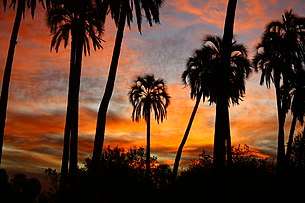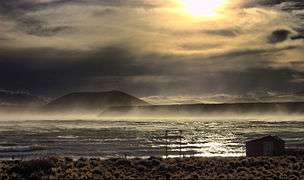Geography of Argentina
The geography of Argentina describes the geographic features of Argentina, a country located in southern South America (or Southern Cone).[1] Bordered by the Andes in the west and the South Atlantic Ocean to the east, neighboring countries are Chile to the west, Bolivia and Paraguay to the north, and Brazil and Uruguay to the northeast.
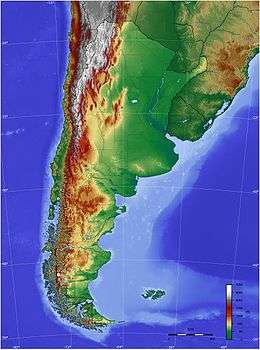 | |
| Continent | South America |
|---|---|
| Region | Southern Hemisphere |
| Coordinates | 34°00′S 64°00′W |
| Area | Ranked 8th |
| • Total | 2,780,400 km2 (1,073,500 sq mi) |
| • Land | 98.43% |
| • Water | 1.56% |
| Coastline | 4,989 km (3,100 mi) |
| Borders | Chile 6,691 km (4,157 mi)[1] Paraguay 2,531 km (1,572 mi)[1] Brazil 1,263 km (784 mi)[1] Bolivia 942 km (585 mi)[1] Uruguay 541 km (336 mi)[1] |
| Highest point | Cerro Aconcagua, 6,960 m[1] |
| Lowest point | Laguna del Carbón, -105 m[1] |
| Longest river | Paraná River, 4,700 km |
| Largest lake | Lake Buenos Aires 1,850 km² |
| Exclusive economic zone | 1,159,063 km2 (447,517 sq mi) |
In terms of area, Argentina is the second largest country of South America after Brazil, and the 8th largest country in the world. Its total area is 2,780,400 km2 (1,073,500 sq mi). Argentina claims a section of Antarctica (Argentine Antarctica) that is subject to the Antarctic Treaty. Argentina also asserts claims to several British South Atlantic islands.
With a population of more than 42.1 million,[2] Argentina ranks as the world's 32nd most populous country as of 2010.
Regions

Argentina's provinces are divided in 7 zones regarding climate and terrain. From North to South, West to East:
- Argentine Northwest: Jujuy, Salta, Tucumán, Catamarca, La Rioja
- Gran Chaco: Formosa, Chaco, Santiago del Estero
- Mesopotamia: Misiones, Corrientes
- Central: Córdoba, Entre Ríos
- Cuyo: San Juan, Mendoza, San Luis
- The Pampas: Santa Fe, La Pampa, Buenos Aires
- Patagonia: Rio Negro, Neuquén, Chubut, Santa Cruz, Tierra del Fuego
Land use
- Arable land: 13.9%
- Permanent crops: 0.4%
- Permanent pastures: 39.6%
- Forest: 10.7%
- Other: 35.4% (2011)
- Irrigated land: 23,600 km² (2012)
- Total renewable water resources: 814 km3/yr
Mountains and hills
Water resources
In Argentina, the fluvial net is integrated by many systems of different economic relevance, which could be measured by their amount of flow and navigability. Water flow relevance is based on its potential to be used for irrigation and as a source of energy. Depending on where the water streams drain, rivers and creeks could be classified into three different kinds of watersheds:
- Open or exorheic watersheds: they have exterior drainage (into the sea) - Parana River, Uruguay River, Negro River
- Closed or endorheic watersheds: they have interior drainage - Atuel River, Diamante River, Tunuyan River
- Areic watersheds: they lack of drainage and could be found in the center-west of the chaquenean plain, on the west of the pampean region and in some patagonic areas
On the other hand, lakes and lagoons are permanent accumulations of water over impervious depressions. Their difference is mainly based on their extension and depth. They are very important for stream regulation, as a source of energy, tourist attraction and its ichthyologic wealth. In Argentina, all major lakes are in Patagonia (Carlevari and Carlevari, 2007).
Rivers
Except in the northeast there are few large rivers, and many have only seasonal flows. Nearly all watercourses drain eastward toward the Atlantic, but a large number terminate in lakes and swamps or become lost in the thirsty soils of the Pampas and Patagonia. The four major rivers systems are those that feed into the Río de la Plata estuary, those made up of the Andean streams, those of the central river system, and those of the southern system.
The Paraná, the second-longest river in South America after the Amazon, flows approximately 4,900 km and forms part of the borders between Brazil and Paraguay, and Paraguay and Argentina. Its upper reaches feature many waterfalls. It is joined by the Iguazú River (Río Iguaçu) where it enters Argentina in the northeast. This area is well known throughout the world for the spectacular Iguazú Falls (Cataratas Iguaçu, meaning "great water"). One of the world's great natural wonders, they are located on the border between Argentina and Brazil with two-thirds of the falls in Argentina. They include approximately 275 falls, ranging between 60 and 80 m high. These falls are higher and wider than Niagara Falls on the border of the United States and Canada. Other tributaries of the Paraná, which feed in from the west, are the Bermejo, Bermejito, Salado, and Carcarañá.
The Uruguay River (1,600 km) forms a part of the borders between Argentina and Brazil and Argentina and Uruguay. It is navigable for about 300 km from its mouth to Concordia. The 2,550-km Paraguay River forms part of the border between Paraguay and Argentina, and flows into the Paraná north of Corrientes and Alto Paraná. These all join to flow into the Río de la Plata, and eventually into the Atlantic Ocean in northern Argentina. Where these rivers meet, a wide estuary is formed, which can reach a maximum width of 222 km.
In north central Argentina, Lake Mar Chiquita is supplied with its water by several rivers. The Dulce River originates near San Miguel de Tucumán and flows southwest into the lake. From the southwest it is also fed by the Primero and Segundo Rivers.
In the northern Patagonia region, the major rivers are the Colorado and Negro Rivers, both of which rise in the Andes and flow to the Atlantic Ocean. The Colorado is fed by the Salado River, which flows from Pico Ojos del Salado in a southeasterly direction to the Colorado. Tributaries of the Salado include the Atuel, Diamante, Tunuyán, Desaguadero, and the San Juan, all of which originate in the northwest Andes. The Negro also has two main tributaries of its own, the Neuquén and the Limay. In the central Patagonia region the Chubut rises in the Andes and flows east to form a sizable lake before making its way to the ocean. The Lake District is also coursed by its share of rivers, all originating in the mountains and flowing to the Atlantic. These include the Deseado, Chico, Santa Cruz, and Gallegos Rivers.
Lakes
The Los Lagos Region (Lake District), on the border of Chile and Argentina in the Andes mountain region, contains many glacial lakes that are carved out of the mountains then filled by melt-water and rain. The most significant of these is Lago Buenos Aires, also known as General Carrera, located in southern Argentina and shared with Chile. It is the largest lake in the country and the fifth largest in all of South America with an average surface area of 2,240 km2.
Moving south along the border one would encounter Lago San Martín, Lago Viedma, and finally Lago Argentino, the second largest lake in this region with an area of 1466 km2. Not far from Lake Buenos Aires on the Castillo Plain near Comodoro Rivadavia is Lake Colhue Huapi.
One of the world's largest salt lakes, and the second largest lake in Argentina, is Lake Mar Chiquita (Little Sea), located in central Argentina. Its surface area varies from year to year and season to season, but has in it wettest periods spanned 5,770 km2. The reservoir created by the Chocón dam, located on the Limay river, is one of the country's largest man made lakes.
Wetlands
Iberá, in the northeast of Argentina, is a biologically rich region, with more than sixty ponds joined to marshes and swampland. The area is extremely humid, and is home to hundreds of bird species and thousands of insects, including a wide variety of butterflies. The area hosts a diverse array of flora and fauna, notably the royal water lily, silk-cotton trees, alligators, and capybara, the largest rodent species in the world.
Climate
Argentina is subject to a variety of climates. The north of the country, including latitudes in and below the Tropic of Capricorn, is characterized by very hot, wet summers (which result in a lot of swamp lands) with mild drier winters, and is subject to periodic droughts during the winter season.
Central Argentina has hot summers with tornadoes and thunderstorms (in western Argentina producing some of the world's largest hail), and cool winters. The southern regions have warm summers and cold winters with heavy snowfall, especially in mountainous zones. Higher elevations at all latitudes experience cooler conditions.
Political Geography
International agreements:
- Party to: Antarctic-Environmental Protocol, Antarctic-Marine Living Resources, Antarctic Seals, Antarctic Treaty, Biodiversity, Climate Change, Climate Change-Kyoto Protocol, Desertification, Endangered Species, Environmental Modification, Hazardous Wastes, Law of the Sea, Marine Dumping, Nuclear Test Ban, Ozone Layer Protection, Ship Pollution, Wetlands, Whaling
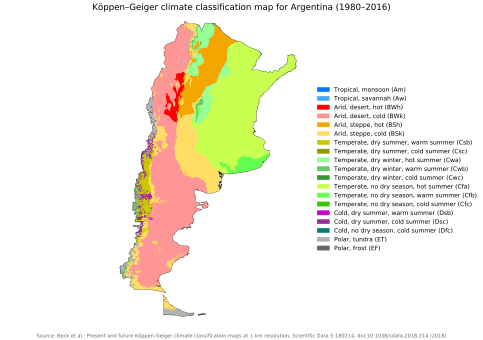 Argentina map of Köppen climate classification zones
Argentina map of Köppen climate classification zones - Signed, but not ratified: Marine Life Conservation
Strategic importance:
- Location relative to sea lanes between South Atlantic and South Pacific Oceans (Strait of Magellan, Beagle Channel, Drake Passage)
Territorial claims
- Land claims
- Falkland Islands
- South Georgia and the South Sandwich Islands
- Argentine Antarctica
- Maritime claims on Argentine Sea
- Territorial sea: 12 nmi (22.2 km; 13.8 mi)
- Contiguous zone: 24 nmi (44.4 km; 27.6 mi)
- Exclusive economic zone: 1,159,063 km2 (447,517 sq mi)
- Continental shelf: 200 nmi (370.4 km; 230.2 mi) or to the edge of the continental margin
National parks
The National Parks of Argentina make up a network of thirty national parks in Argentina. The parks cover a very varied set of terrains and biotopes, from Baritú National Park on the northern border with Bolivia to Tierra del Fuego National Park in the far south of the continent (see List of national parks of Argentina).
The creation of the National Parks dates back to the 1903 donation of 73 square kilometers of land in the Lake District in the Andes foothills by Francisco Moreno. This formed the nucleus of a larger protected area in Patagonia around San Carlos de Bariloche. In 1934, a law was passed creating the National Parks system, formalizing the protected area as the Nahuel Huapi National Park and creating the Iguazú National Park. The National Park Police Force was born, enforcing the new laws preventing tree-felling and hunting. Their early task was largely to establish national sovereignty over these disputed areas and to protect borders.
Five further national parks were declared in 1937 in Patagonia and the service planned new towns and facilities to promote tourism and education. Six more were declared by 1970.
In 1970 a new law established new categories of protection, so that there now were National Parks, National Monuments, Educational Reserves and Natural Reserves. Three national parks were declared in the 1970s. In 1980, another new law affirmed the status of national parks - this law is still in place. The 1980s saw the service reaching out to local communities and local government to help in the running and development of the national parks. Ten more national parks were created with local co-operation, sometimes at local instigation. In 2000, Mburucuyá and Copo National Parks were declared, and El Leoncito natural reserve was upgraded to a national park.
The headquarters of the National Park Service are in downtown Buenos Aires, on Santa Fe Avenue. A library and information center are open to the public. The administration also covers the national monuments, such as the Petrified Forest, and natural and educational reserves.
See also
- List of islands of Argentina
- List of volcanoes in Argentina
- Protected areas of Argentina

References
- "The world Factbook: Argentina". The World Factbook. Central Intelligence Agency. Retrieved December 13, 2013.
- "CIA World Factbook: Argentina". Retrieved 2012-06-26.
Bibliography


- UT Perry–Castañeda Map - Argentina Map Website Map
- Carlevari I. y R. Carlevari. 2007. La Argentina. Geografía económica y humana.14° edición. Alfaomega grupo editor. 543 pp.

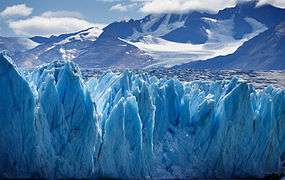
.jpg)

